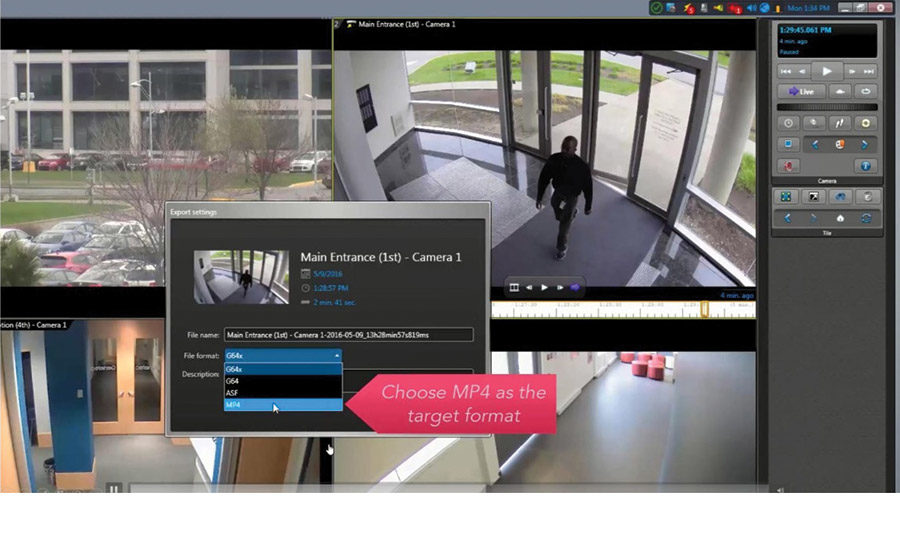Video management systems (VMS) have been evolving for several years, starting out as proprietary, closed solutions offered by manufacturers that would work only with their cameras and/or recorders. For the most part, today’s solutions are open-platform, manufacturer-independent, feature-rich software that provides a high level of control and functionality designed to make end users’ lives easier with regard to video surveillance applications.
The basic features, functionality and capabilities of VMS haven’t really changed. What has changed is the maturity of the technology and how it is applied. As a result, integrated systems, analytic capabilities and other advancements are leading the growth in the VMS market, which is largely
dominated by open-platform systems.
Broader, Deeper Integrations
At the top of most end users’ VMS wish lists is the ability to integrate video and a host of other systems, such as access control and security systems, into the solution.
“Without getting into the minutia, what most customers are looking for is interoperability; openness to work with multiple cameras; switches; servers; integration with access control and other third-party products; and to do all of that reliably,” says Brent Edmunds, president and co-founder, Stone Security, a systems integration firm based in Salt Lake City. “It allows the customer to feel like they aren’t being cornered, they aren’t being put into a proprietary-type situation that they might regret later.”
In the past, interoperability and open platforms were afterthoughts, if they were thought of at all, but that couldn’t be further from the truth today.
“I don’t think it was as important a long time ago as it is now because people do expect everything to just work,” says Tim Ferrian, vice president and employee owner at Pro-Tech Design, a Minnetonka, Minn.-based systems integrator.
“Integrating with access control, building automation systems, elevator controls and things like that — people just expect that. Being mobile-enabled is a huge deal and every system should just be mobile-enabled and it should be free. That’s the mindset.”
Today’s open-platform VMS are meeting this need while also delivering ease of use and ease of installation, which in some regards can mirror the DIY trend that’s taken the industry by storm.
“Because IP video and VMS are more mainstream now, we’re seeing a lot of clients who actually take some of the programming and configuration of those — and sometimes the installation and upgrading — into their own hands rather than use an integrator like us,” Ferrian says. “That presents a risk to the integrator; it forces us to try and figure out what’s next for us, what’s the next thing our clients need so we stay relevant.”
All of these advanced capabilities and integrations now make it possible for many VMS to sit at the center of overall security operations, making it easier for end users to manage not just their video systems, but much more.
“We are seeing a lot of integrations and unifications with other security applications, such as unification between video VMS and access control platforms to support a single interface instead of having one monitor for video and another monitor for access control,” describes Mike Tabola, senior product manager, Tyco Security Products, Westford, Mass.
In fact, the demand for broader and deeper integrationsis driving innovation in today’s VMS.
“For VMS providers to really thrive, they need to listen to customer demand, and provide deep integration with the most popular camera manufacturers,” says Steve Bocking, product manager, software, Hikvision USA, City of Industry, Calif.
“Some features that are standard on many IP cameras today, such as onboard analytic capability, would have been high-cost specialty features even three years ago. I think it is critical for VMS companies to ensure they’re adding the full feature sets of third-party cameras, so that customers can take advantage of newest edge features.”
Leveraging Features & Relationships
From integrators’ perspectives, this means expanding skills and knowledge to provide customers with the best possible system.
“For the integrator, setting up the system will require a broader level expertise and knowledge about both analytics and unification in order to set up the system properly to work for the end user. These features should make it easier for the integrator to sell the value and powerful capabilities ofthese systems,” Tabola says.
Both Edmunds and Ferrian agree that by limiting the number of VMS providers they partner with, integrators can more quickly and easily gain strong familiarity with a solution, which can really pay off for end users. “For us, it allows customers to feel like they’re not being cornered and they’re not getting locked into something proprietary. They like having options, so they like having an open system,” Edmunds says.
An added bonus of the “fewer and deeper” approach to technologies is the potential impact on an integrator’s bottom line. “Having a partner in a VMS manufacturer can lead to more business development,” says John Lathrop, president of sales for Advent Systems, a security integration firm located in Elmhurst, Ill.
Open platforms allow integrators to provide solutions for their customers that go beyond security. “People want more business intelligence and by leveraging VMS video analytics integrators can provide customers with the capability to develop targeted marketing techniques and campaigns based on what they learn, such as if customers spend more time in specific aisles when shopping,” Tabola says.
“[Security integrators] can now integrate new technologies such as video analytics in order to create actionable data that will improve business and operational intelligence, allowing the customers to go beyond security and improve operations and day-to-day efficiency, removing the burden from the operator,” says Jimmy Palatsoukas, director of product marketing, Genetec, Montreal.
Efficiency is a major benefit of open-platform, integrated systems. “Our customers — and their processes — are becoming increasingly sophisticated and want their security and IT teams to be as efficient as possible,” Palatsoukas says. “This means VMS vendors need to look beyond managing and monitoring video, and really start to think about how to help their customers become more productive. Helping security teams make better decisions and respond to situations more quickly will have an impact on VMS development in the years ahead.”
Flexibility is the name of the game for VMS providers and camera manufacturers alike, who work to ensure that their solutions offer a wide assortment of features, even if end users aren’t going to use them now, but may want them in the future.
“They are there for a reason,” says Mario Verhaeg, product manager, Bosch Security Systems, Fairport, N.Y. “Instead of asking what cameras a customer wants, or what features are required, ask the customer what the problem is he wants to solve with a video surveillance system. This could be something totally different than you expect. Tailoring the video management system with a focus on solving this problem will give the greatest benefits for the end user of the system, as it will increase their return on investment.”
Analyzing Analytics
VMS providers are focusing much effort on developing analytics in their solutions with an eye towards going beyond traditional security and loss prevention applications, into business intelligence.
“Today, end user customers are able to do more with the analytics in the VMS,” says Mike Tabola of Tyco Security Products. “For example, if you want to search past video based on a new set of analytics rules you can do that in the VMS, making it possible to go back in time to identify important data. Video analytics on the camera provides real time analytics, while video analytics on the VMS will give you archival capabilities.”
These analytics will prove to be even more helpful moving forward, as the technologies continue to gain traction and mature. The growth and development of analytics today is a far cry from the early days, when technologies were oversold and didn’t necessarily meet end users’ expectations, says Genetec’s Jimmy Palatsoukas.
The H.265 Factor
As 4K and other higher-resolution cameras continue to become more popular, integrators and end users alike will come to rely on the new, more efficient H.265 compression codec to keep bandwidth and storage costs from skyrocketing. While H.265 has made strides in the industry over the last year or so, one barrier to wider acceptance has been the ability for VMS to handle video that’s been compressed by the codec. These solutions are becoming more commonplace but there is still much room for improvement in adoption.
“Some VMS systems currently support H.265, but the market will see even more VMS systems adopt this standard over the next 12 to 18 months,” says Mike Tabola of Tyco Security Products.
The VMS market is following the global industry trends with a certain delay, which Jimmy Palatsoukas of Genetec says is to be expected with any change on the order of transitioning from H.264 to H.265.
“Changing the compression format is never seamless. Camera vendors need to deal with increased processing power requirements. Not all VMS solutions are able to support H.265-capable devices yet, as some companies are more agile than others,” he says.
For example, simply accepting an H.265 feed is not the same as being able to scale a solution to support dozens, hundreds, and thousands of H.265 camera streams. Despite the challenges, H.265 and other codecs are seen as the natural evolution of the VMS market.
“We’ve planned well in advance for H.265 support and our VMS architecture not only supports H.265 — recording and viewing — but has also been designed to scale for both server and workstation,” Palatsoukas says. “H.265 support also needs to consider the implications on both the archiving servers and the actual monitoring workstations.”
The main challenge for VMS providers in catching up with video resolution trends has been processing power.
“As we are able to more effectively compress video, using technology such as H.265, it does take more computing power on the VMS client side to decompress and decode the video stream for viewing,” says Steve Bocking of Hikvision USA. “It is important for video management client software to take advantage of GPU decoding available on graphic cards. This is still a relatively rare feature on most VMS clients today. It would benefit integrators and end users alike if VMS providers made this feature more readily available.”
MORE ONLINE
For more information about VMS and video management, visit SDM’s website, where you’ll find the following articles.
“Advances in Video Analytics Rebuild Trust & Growth”
www.SDMmag.com/advances-video-analytics
“Nebulous No More”
www.SDMmag.com/nebulous-no-more
“Recording Technologies Give RMR a Boost”
www.SDMmag.com/recording-technologies-RMR-boost






